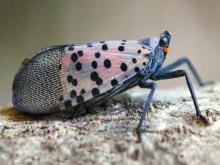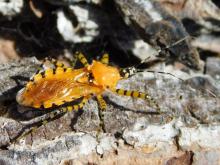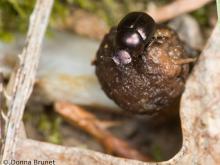Land Invertebrates
Media

Species Types
Scientific Name
Lycorma delicatula
Description
The spotted lanternfly has not yet been found in Missouri, but it is present in several eastern states. It has the potential to damage our forests and food supply by feeding destructively on trees and crops.
Media

Species Types
Scientific Name
Melanoplus punctulatus
Description
The pine tree spur-throat grasshopper usually lives in wooded areas, where its mottled, brownish-gray camouflage protects it when it rests on tree trunks.
Media
Species Types
Scientific Name
About 11 species in North America north of Mexico
Description
Mantidflies look like a cross between a lacewing insect and a praying mantis. They are small, delicate creatures with intricately veined wings, but the front half looks like a mantid, complete with raptorial forelegs.
Media

Species Types
Scientific Name
More than 40 species in 3 genera in North America north of Mexico
Description
Ebony bugs are definitely true bugs, but they look a lot like tiny, shiny black beetles. Their bodies are fat ovals. They’re almost always seen on flower clusters and immature seeds, often on members of the carrot or parsley family.
Media

Species Types
Scientific Name
Oncopeltus fasciatus
Description
The large milkweed bug, with its bold black-and-orange pattern, is one of the most beautiful of the true bugs. Look for it on milkweeds, from midsummer through the first hard freeze.
Media

Species Types
Scientific Name
About 175 species in North America
Description
Earthworms are familiar to just about everyone who digs in the soil. They play a major role in the nutrient cycling and structure of soils. There are many species. The most familiar ones in Missouri are nonnative.
Media

Species Types
Scientific Name
Pselliopus barberi
Description
The orange assassin bug, Pselliopus barberi, is about ½ inch long and is one of our most attractive non-butterfly insects. They overwinter in groups as adults under loose bark.
Media

Species Types
Scientific Name
About 30 species in North America north of Mexico
Description
Members of the pygmy grasshopper family are small and have a distinctively elongated pronotum — this plate, which only covers the shoulders of most other grasshoppers, extends back to cover the abdomen in this family. Most live along streams and in other wet habitats.
Media

Species Types
Scientific Name
Canthon spp.
Description
Tumblebugs in genus Canthon are usually seen on, near, and beneath poop. They are sometimes seen rolling dung balls away from the original heap, heads down and pushing the ball backward with their hind legs.
Media

Species Types
Scientific Name
About 1,700 species in North America north of Mexico
Description
The scarab beetle family is very large, with breathtaking variety — and often great beauty. Many scarabs are large and colorful.
See Also



Media

Species Types
Scientific Name
Cisseps fulvicollis
Description
The yellow-collared scape moth is more often “orange-collared.” And whether you think it looks more like a firefly or a wasp, it’s still a moth!
Media

Species Types
Scientific Name
Nearly 150 species in North America north of Mexico
Description
Slim, delicate plume moths are instantly recognizable by their T-shaped silhouette, long legs, and muted shades of tan and brown. It can be hard to separate the various species.
Media

Species Types
Scientific Name
Pyrrharctia isabella
Description
Not many people know the adult Isabella tiger moth when they see one, but we’re all acquainted with its caterpillar, the woolly worm, or woolly bear.
About Land Invertebrates in Missouri
Invertebrates are animals without backbones, including earthworms, slugs, snails, and arthropods. Arthropods—invertebrates with “jointed legs” — are a group of invertebrates that includes crayfish, shrimp, millipedes, centipedes, mites, spiders, and insects. There may be as many as 10 million species of insects alive on earth today, and they probably constitute more than 90 percent all animal species.





















